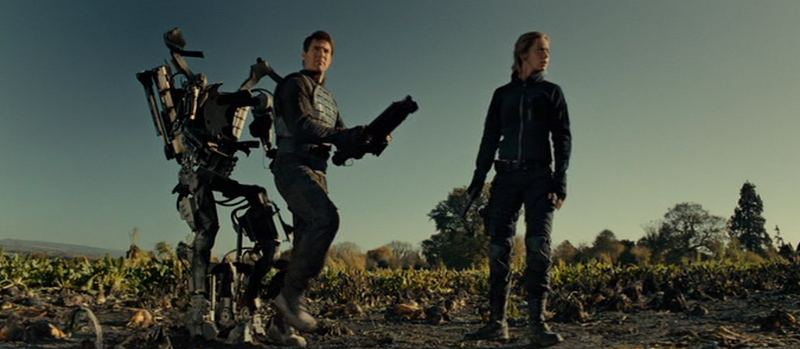
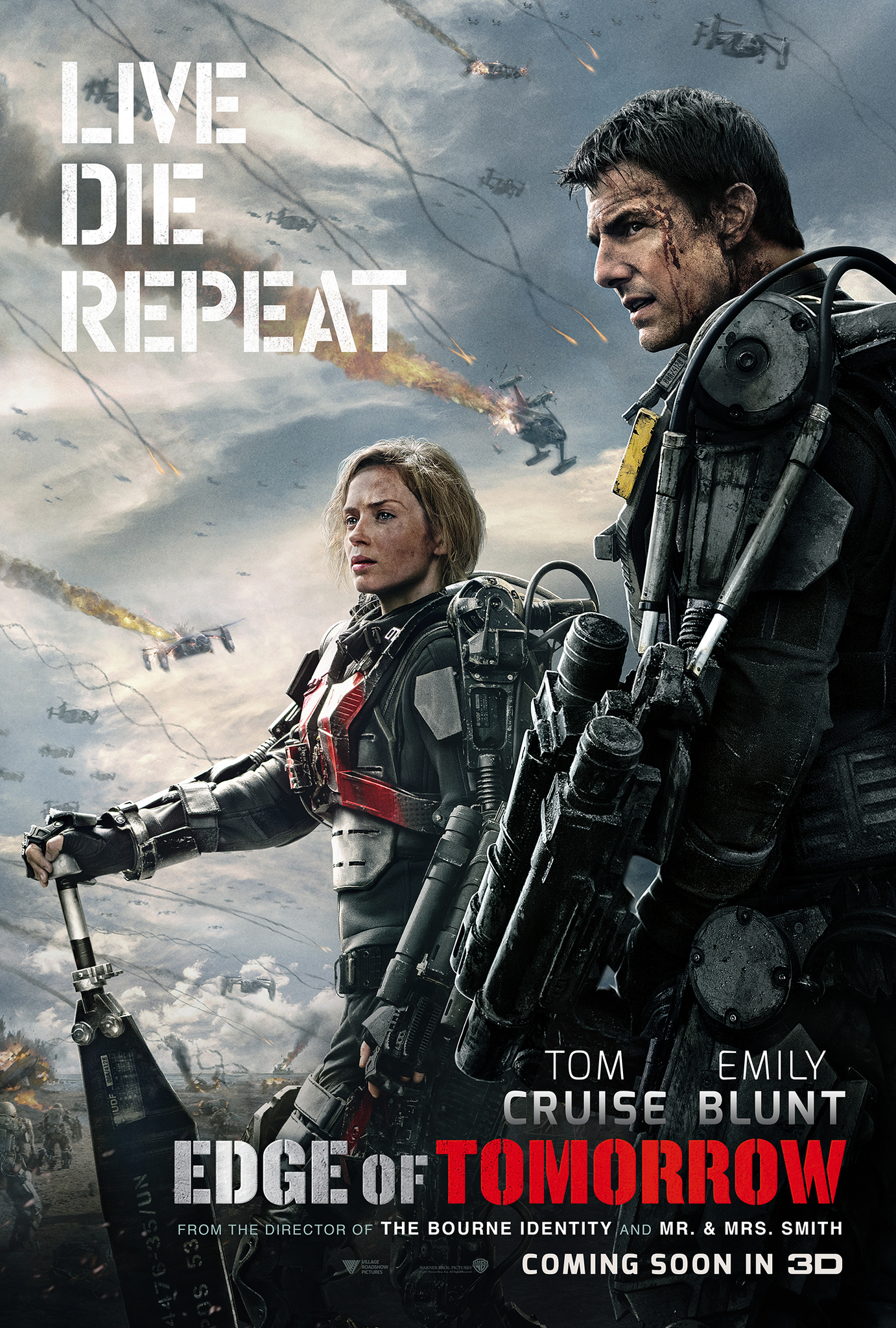
“Battle is the great redeemer. It is the fiery crucible in which true heroes are forged. The one place where all men truly share the same rank, regardless of what kind of parasitic scum they were going in.”
Edge of Tomorrow, also known as Live. Die. Repeat., is the cinematic equivalent of a combat-based video game. The film never takes itself too seriously and raises some fun questions about its interesting time travel mechanics. We get a fairly standard Tom Cruise action performance as well as an unexpectedly convincing portrayal of a world-class super-soldier from Emily Blunt.
Director Doug Liman’s film opens with a montage of newsreel, unloading the general premise in a few minutes. Aliens (called Mimics) have landed in Germany and taken over most of Europe. Humanity has formed a global alliance—the United Defense Force—to fight them. Using mechanized exoskeletal suits that enhance their fighting capabilities, the UDF have achieved a minor victory at Verdun.
Major William Cage (Cruise), a public relations officer who spends his time motivating citizens to join the military, is inexplicably sent to the frontlines by UDF General Brigham (Brendan Gleeson). Cage protests, and is tased as he flees, waking up as a member of Master Sergeant Farell’s (Bill Paxton) J-Squad and demoted to the rank of Private. Although the chain of events that force Cage onto the frontlines is somewhat contrived, the playful tone was set by the preceding scene (the conversation with Brigham) and it is easy to swallow the fiction required for Cage to arrive on the battlefield as a novice.
As the new soldier Cage is thrust into combat for the first time he does not even know where to find the safety on his weaponry. Soon after dropping into the battle from the air, the squad is overwhelmed by the spidery, tendrilled Mimics, though Cage is able to kill one of them by using an explosive. The Mimic’s acidic blood splatters onto his face and eats away at his flesh. Cage has died. (Side note: I am very surprised this film was awarded a PG-13 rating.)
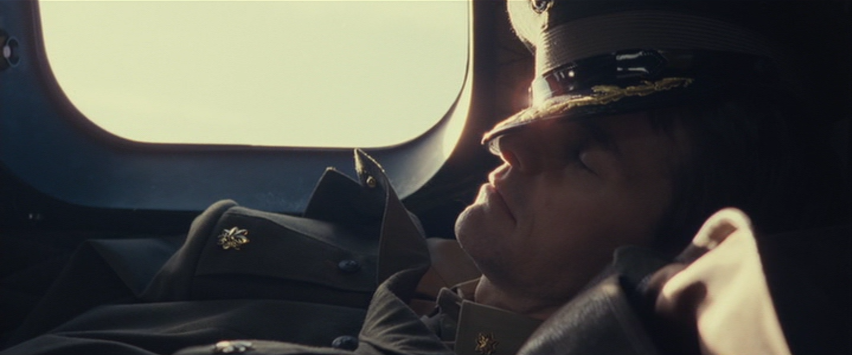
He wakes up at the airport, and meets Master Sergeant Farell again. He is introduced to J-Squad—again. But no one remembers meeting him. He relives the day and dies again. He has no idea why, but it keeps happening, like a sci-fi Groundhog Day. This narrative device is a source of continuous humor, as Cage is killed in a plethora of ways (sometimes not even making it onto the battlefield), finds the most efficient ways to move through repetitive conversations, and speaks the words of others in unison with them.
The battlefield scenes are incredibly hectic, with rapid camera movement, and busy backgrounds full of aircraft, explosions, smoke, and airborne rounds of ammunition. Several times we shift to first-person point of view, where a graphic overlay populates the screen similar to a heads up display in a first-person shooter; and failure to reload a weapon in a timely fashion is a repeated cause of death—further analogizing the film with the world of combat gaming.
Rita Vrataski (Blunt) is the single soldier who fights without a helmet, ostensibly because “it gets in the way” (the excuse Cage uses later for ditching his own); but this choice was probably made because you simply don’t cast Emily Blunt and then cover her face for the entire film. Liman also seems very fond of the shot of Rita rising from her yoga position, reusing it several times. The initial interactions between Cage and Blunt are humorous, and completely subvert the audiences expectations. Cage is wounded trying to save Rita. Lying on his back, he requests that Rita evaluate the damage. “Is there a lot of blood?” he asks. “There’s a hole in your chest,” Rita replies, as she callously takes his battery pack and leaves him to die. During one time loop, Cage prevents her from dying in combat. When she realizes that he had foreknowledge of her death, she requests that he seek her out the next time he wakes up. When he does so, we begin to learn why he has this rare ability and how he may be uniquely capable of saving humanity.
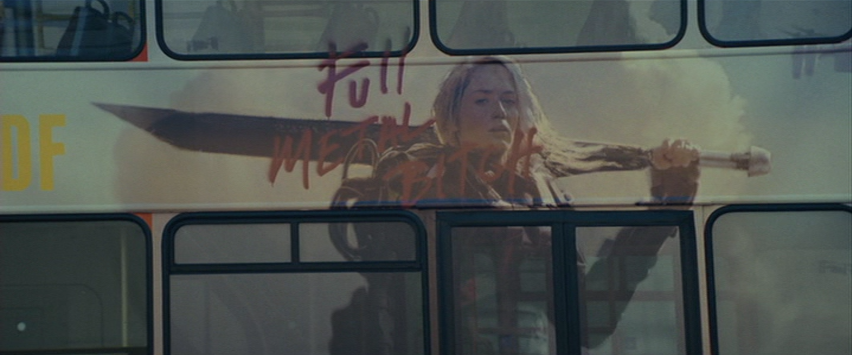
Rita introduces Cage to a scientist, Dr. Carter (Noah Taylor) who has some peculiar theories about the Mimics, including their ability to manipulate time. Together, they convince Cage that he must continue to die repeatedly until they can complete their objective, which is to find the brain of the alien hive mind and destroy it.
Eventually, the resets begin to weigh down the narrative, and they are thankfully mostly absent from the latter parts of the film. The scriptwriters—riskily, but fruitfully—decided to trust the viewer to make the mental leap in grasping that the repetition is still happening without us witnessing it. Instead we are clued in on the repetition by Cage’s foreknowledge of events. This is clever, because when his actions indicate that he is exploring a new situation for the first time, we, along with Rita, can be fooled.
The film is not without its flaws. One problem is the growing familiarity between Rita and Cage. It makes sense narratively for Cage to learn more about Rita, and the script reflects this. The actual dialogue seems to adequately keep Rita cold and distant from Cage as well, but too often in the repetition, it appears as if Rita is growing exasperated with Cage, and becoming familiar with him. But according to the internal logic of the film, she really only knows Cage for a few hours.
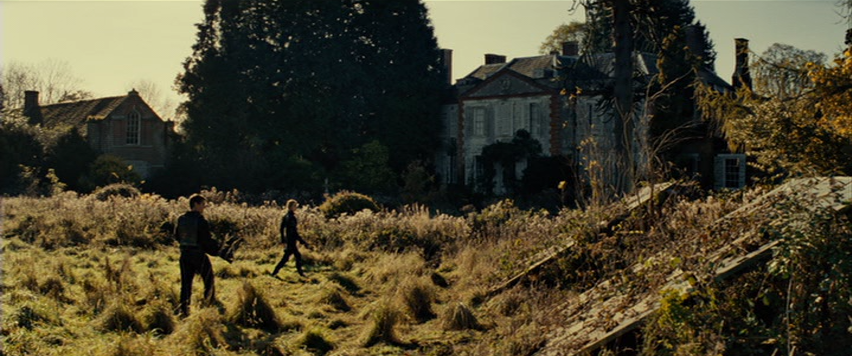
However, I think the film flows better and has a greater comedic value as is, so I don’t necessarily think there was a misstep here; just that the complexity of the narrative kind of painted the filmmakers into a tight corner. Where I do think they fumbled slightly was in trying to force the romantic relationship between Cage and Rita, which stems from the same root issue. It is impossible for Rita to have absorbed all of their interactions the way Cage has and reciprocate his feelings—which is a concept that many time travel films with romantic subplots play with, but feels like an afterthought here and merely grafted on to satisfy some kind of unspoken criteria for blockbuster films.
Overall, the film is original enough to warrant a viewing. Some parts do feel a bit forced, and the story feels very streamlined, lacking the fat that can add tremendous flavor to this sort of hypothetical scenario. Despite my gripes, there was a lot of things done well here. While it may not become a classic, it’s ideas are interesting enough to warrant your time.